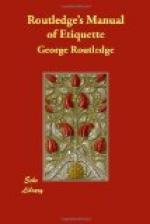In laying the cloth, care should be taken, not only that the table should occupy the centre of the room, but that the cloth should be spread to leave the pattern in the centre of the table, with the design proceeding from the head, and as the cloth is now almost universally left on the table for the dessert, lay-overs or slips are placed round, broad enough to reach two or three inches beyond the plate, to be carefully removed in folds when the crumb-brush has been used after the dinner is removed.
The table being spread, and the dinner announced by the butler or principal waiting servant, the lady of the house must quietly indicate the arrangement of her guests according to rank, age, or any local or occasional distinction, the master of the house leading out the first lady, and the mistress following last with the most distinguished gentleman, who, seated at her right hand, is her assistant in the duties of the table.
The soup and fish are usually placed on the table together, and the covers removed at once; the soup to the lady, the fish before the master; or if two soups, and one should be turtle, that must be at the head. Soup is sent round without inquiry to everybody, to be accepted or rejected at pleasure. Sauterne, sherry, or Madeira may be offered after the soup. After turtle soup, punch is the correct liquor. The fish is carved and served round in the same way as the soup, if only one kind of fish be served; if more, the choice must be left to the guest.
After the soup and fish are served, the Removes, as they are generally termed, that is, the pieces de resistance, the stronghold of the dinner, are brought in; but before they are carved, two or more entrees are usually handed round, and if champagne be introduced, this is the time for it to be offered.
In carving the removes, a servant must be at the side of the carver with the plate, which he must as quickly as possible pass to the guest for whom it is required, another servant following with the vegetables or sauces. If only one servant be employed, the vegetables should be on the table, that the guests may help themselves, for nothing can be more vexatious than to have to wait for them for a quarter of an hour after you have been served with the meat. The same may be said of the sauces, so often, at a scantily-attended table, withheld until you no longer care for them. Such wines as the master of the house chooses to bestow must be offered when needed. Water caraffes will be within the reach of all, and beer, if called for, must be served.




